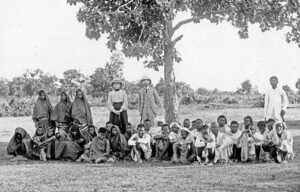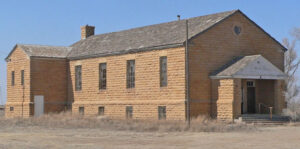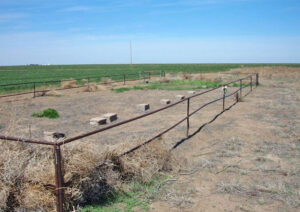Menno, Kansas, in Hamilton County, started when a small colony of Mennonites from McPherson and Marion Counties migrated to the western edge of the state in 1906. After finding land suitable for cattle ranges, they moved optimistically and attempted to coerce the land to grow crops such as wheat and sorghum. Within a couple of years, the colony’s perseverance paid off, and they reaped the benefits of their crops. With the money earned from harvest, the Mennonite families built farms with barns and houses, a community church, and a post office established on February 19, 1907.
The first few years were prosperous, and Menno began to grow. Unfortunately, the farming families discovered that their cattle range land was less suitable for farming than they had hoped. A few dry seasons with too much wind and hot sun left the families of Menno without crops or an income.
In 1910, Menno’s population was 25.
By 1911, all was lost. The church building was sold to a German Lutheran colony in an adjoining county, and most of the original settlers of Menno moved on, either returning to central Kansas or pushing on to Colorado. However, two original Mennonite settlers remained, brothers Pete and Henry Dyck. After purchasing the church, some families of the German Lutheran sect migrated to Menno, but the church building was never utilized for religious worship.
The Menno Community Club was organized early on after the arrival of the German Lutheran sect. In 1923, the club purchased the building, giving it a multi-purpose function for the isolated rural families living in a four-county area. Within no time, the Club organized baseball teams, presented talent plays, and socials and pie-suppers occurred. Menno’s pot office closed on February 15, 1924.
In the next years, the agricultural situation improved with new ways of understanding the land and the best crops to plant. From 1911 until the late 1930s, there were no failed harvests. Planting wheat was not attempted until 1928; even then, it was only of secondary importance. With the land having had time to recover, the yields were excellent, and the harvest was profitable. But, the success lasted only a few years until 1931. With a bleak agricultural outlook during the Great Depression, the fields sat barren, resulting in dust and wheat planting damage, and sage-covered the sandhills.
However, the Menno Community Club rallied to give the area the hope and faith it needed at the time. With a membership of over 700 people, the club mustered its spirit to raise sponsorship money to construct a new community building by the Works Progress Administration. Once the project was approved, the old Mennonite church building was demolished to make way for the new building.
Contributions, not taxes, provided the sponsor’s share in the building. Designed by Howard T. Blanchard of Garden City, Kansas, at an estimated cost of $18,555, the concrete for the foundation was poured on July 1, 1936. The community residents declared a holiday, with nearly every able-bodied man and boy in the neighborhood spending all day on the job. The community ladies joined in the work by providing lunch and dinner.
The men poured 370 sacks of cement into the foundation, each 20 inches in circumference and 350 feet in height. As construction continued, community meetings were held, at which volunteers were always requested and always found. The building was constructed of local limestone quarried in the southwest part of Hamilton County, about 15 miles west of the new building site. The design of the building was a good example of a modern adaptation of early American architecture.
“The approximate size of the structure is 36 feet in width by 76 feet in length. It is constructed of native stone walls laid in coursed ashlar style, wood framed first floor and wood framed roof covered with cedar shingles. The first floor will accommodate the main auditorium with stage and dressing rooms on either side; toilet rooms, and restroom facilities will serve the auditorium. The seating capacity of this room is approximately 230 people. The basement floor will have a spacious dining room, seating approximately 100 people. Other rooms serving this floor will be men’s and women’s toilets, kitchen, sewing room, storage room, and furnace room.”
— The Syracuse Journal, May 21, 1937
After almost a year of construction and furnishing, the new Menno Community Building was dedicated on June 17, 1937, with 1,000 attendees.
Within no time, the new Menno Community Hall served a multi-purpose function for the families of the surrounding areas. Along with worship services and Sunday school, pie and box suppers, 4-H meetings, card parties, dances, and weekly sewing circle meetings took place at the new facility. Once a year, a bazaar was held to auction off the items made during these weekly meetings. The money received from the auctions was used to help with maintenance expenditures for the building. The local rural school children and other youngsters from the surrounding areas performed musical and talent programs in the auditorium.
The building continued to serve the people of the four-county area into the 1980s. However, when the rural schools closed one by one, and the children were bussed into town for their education, most of the activities that were held within the Menno Community Hall were also moved into town. Thus, the Menno Community Hall also closed when the final rural school closed in the 1980s. Afterward, the vacant building remained clearly visible on a hilltop as a tribute to the community.
Unfortunately, the building was severely damaged by vandals in 1994, but once again, area residents rallied to save the building from more vandalism and possible destruction. Menno Community Hall was placed on the National Register of Historic Places in 2003.
Menno was located about 18 miles southeast of Syracuse, Kansas.
©Kathy Alexander/Legends of Kansas, August 2024.
Also See:
Extinct Towns in Hamilton County
Hamilton County Santa Fe Trail
Sources:
Blackmar, Frank W.; Kansas: A Cyclopedia of State History, Vol I; Standard Publishing Company, Chicago, IL 1912.
National Register of Historic Places
Wikipedia




